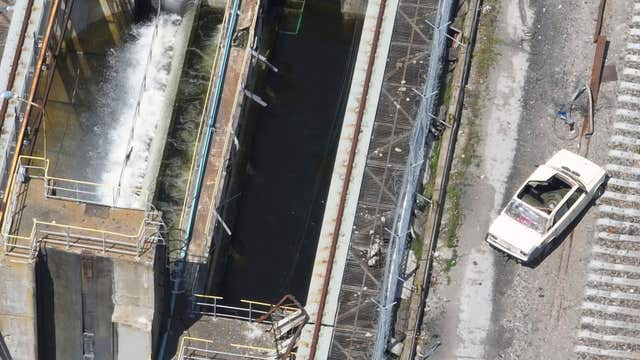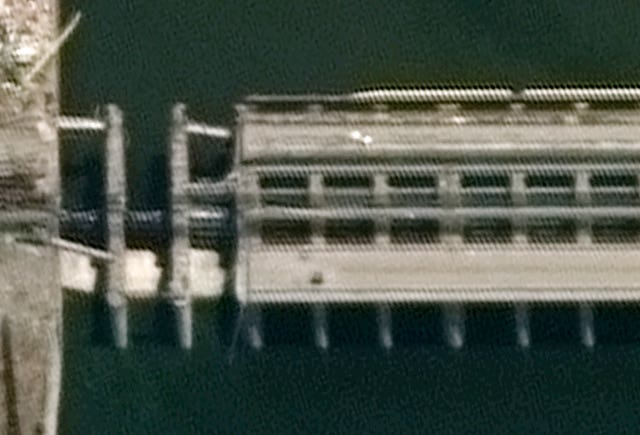
Russia had the means, motive and opportunity to bring down a Ukrainian dam that collapsed earlier this month while under Russian control, according to exclusive drone photos and information obtained by the Associated Press.
Two officials said Russian troops were in a crucial area inside the Kakhovka dam where the Ukrainians say the explosion that destroyed it was centred. Images taken from above and shared with AP also appear to show an explosives-laden car on the structure.
Ukrainian officials say the photos show the Russians’ intent to rig it, and that they had the access and control to do so.

The dam’s destruction led to deadly flooding, endangered crops in the world’s bread basket, threatened drinking water supplies for thousands and unleashed an environmental catastrophe. Ukrainian commanders say it also scuppered some of their plans to take Russian positions in a counter-offensive that is in its early stages.
Each side has accused the other of destroying the dam, but the Russian allegations — that it was hit by a missile or taken down by explosives — fail to account for a blast so strong that it registered on seismic monitors in the region.
Moscow has benefitted from the timing of the massive flooding that followed the explosion — though areas it occupies also experienced a deluge and the consequences may have been more extensive than expected.
In the region around the dam, the Dnieper River forms the front line between Russian and Ukrainian forces, with Russia’s troops in control of the dam.
Two Ukrainian commanders who had been in the area told AP that the rising waters quickly swamped their positions and Russian ones and destroyed equipment, forcing them to start again with planning and leaving them facing a much larger distance to cover, all in mud.
One commander, Illia Zelinskyi, of the Bugskiy Gard, said: “It’s a regular practice, to mine (places) before a retreat. In this context, their actions were to disrupt some of our supply chains as well as complicate a crossing of the Dnieper for us.”

In recent weeks, Ukraine’s armed forces have reported limited gains in the beginnings of a counter-offensive to take back territory seized by the Russians since their invasion in February 2022.
Russian President Vladimir Putin indirectly acknowledged the advantage to his forces last week, although he maintained Moscow’s denials of responsibility: “This may sound weird, but nonetheless. Unfortunately, this disrupted their counter-offensive in that area.”
In the days leading up to the dam’s destruction on June 6, Ukrainian military drone videos showed dozens of Russian soldiers camped on a bank of the Dnieper, relaxed as they walked back and forth to the dam with no cover — suggesting their confidence in their control of the area and especially the dam, which was strategically crucial.
Photos from drone footage obtained by AP and dated May 28 showed a car parked on the dam, its roof cut open to reveal enormous barrels, one with what appears to be a land mine attached to the lid and a cable running towards the Russian-held side of the river.
It is not clear if any car bomb went off. A satellite image from June 16 shows a fuzzy object on top of the dam that could be the vehicle — but it was taken at such a distance and resolution as to make it impossible to know for sure.

A Ukrainian special forces communications official said the drone photos are evidence the dam was rigged. He said the purpose of the car was twofold: to stop any Ukrainian advance on the dam and to potentially amplify the planned explosion originating in the machine room. Even if the car exploded, it would not have been sufficient to bring down the dam.
Kakhovka is one of a series of Soviet-era dams along the Dnieper River that were built to withstand enormous force, amounting to thousands of pounds of explosives.
Ukraine is not believed to possess any single missile with that kind of power.
Nor does it seem credible that Ukrainian commandos could have sneaked in thousands of pounds of explosives to blow the dam, which was completely controlled inside and out by Russian soldiers for months.
Ukrainian President Volodymyr Zelensky said as early as October 2022 that the dam was mined.
A Kremlin spokesman said on Monday that UN aid workers who want to visit areas ravaged by the dam collapse cannot go there because fighting in the war makes it unsafe.
The UN rebuked Moscow on Sunday for allegedly denying aid workers access to Russian-occupied areas where residents are stranded amid “devastating destruction”.
Kremlin spokesman Dmitry Peskov did not explicitly admit that Russia had blocked UN access, but told a conference call with reporters that Ukrainian attacks made a visit too risky.
“There has been constant shelling, constant provocations, civilian facilities and the civilian population have come under fire, people have died, so it’s really difficult to ensure their security,” he said.


Comments: Our rules
We want our comments to be a lively and valuable part of our community - a place where readers can debate and engage with the most important local issues. The ability to comment on our stories is a privilege, not a right, however, and that privilege may be withdrawn if it is abused or misused.
Please report any comments that break our rules.
Read the rules here